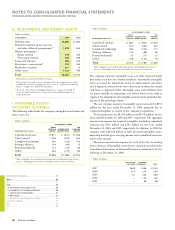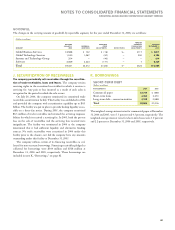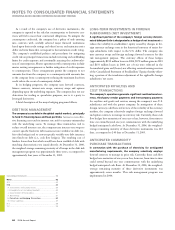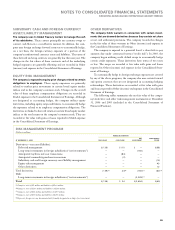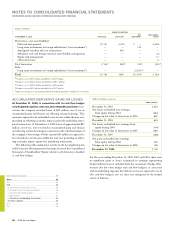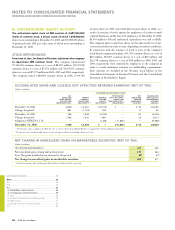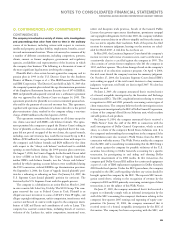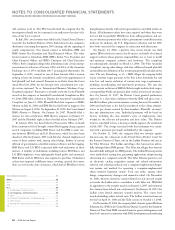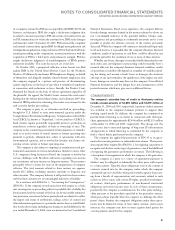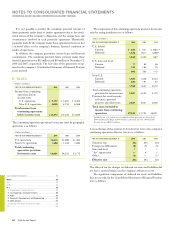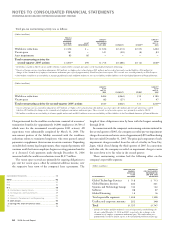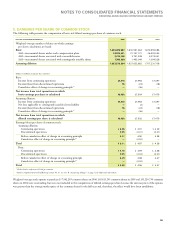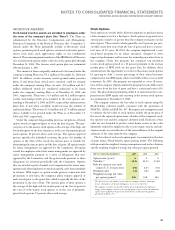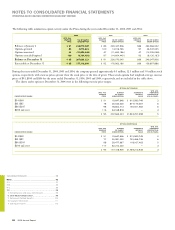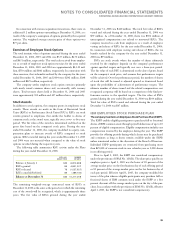IBM 2006 Annual Report Download - page 91
Download and view the complete annual report
Please find page 91 of the 2006 IBM annual report below. You can navigate through the pages in the report by either clicking on the pages listed below, or by using the keyword search tool below to find specific information within the annual report.Black
MAC
390 CG10
O. CONTINGENCIES AND COMMITMENTS
CONTINGENCIES
The company is involved in a variety of claims, suits, investigations
and proceedings that arise from time to time in the ordinary
course of its business, including actions with respect to contracts,
intellectual property, product liability, employment, benefits, securi-
ties and environmental matters. These actions may be commenced by
a number of different constituents, including competitors, partners,
clients, current or former employees, government and regulatory
agencies, stockholders and representatives of the locations in which
the company does business. The following is a discussion of some of
the more significant legal matters involving the company.
Plaintiffs filed a class-action lawsuit against the company and its
pension plan in 1999 in the U.S. District Court for the Southern
District of Illinois, Cooper et al. v. The IBM Personal Pension Plan
and IBM Corporation. The District Court held on July 31, 2003 that
the company’s pension plan violated the age discrimination provisions
of the Employee Retirement Income Security Act of 1974 (ERISA).
IBM and plaintiffs subsequently entered into a settlement agreement
that was approved by the District Court on August 16, 2005. The
agreement provides for plaintiffs to receive incremental pension ben-
efits and for the payment of costs and attorneys fees. This agreement,
together with a previous settlement of a claim referred to as the partial
plan termination claim, resulted in the company taking a one-time
charge of $320 million in the third quarter of 2004.
This agreement terminated the litigation on all claims except for
two claims associated with IBM’s cash balance formula. The agree-
ment permitted the company to appeal the District Court’s ruling in
favor of plaintiffs on these two claims and stipulated that if the com-
pany did not prevail on appeal of the two claims, the agreed remedy,
including costs and attorneys fees, would be increased by up to $1.4
billion—$780 million for an age discrimination claim with respect to
the company’s cash balance formula and $620 million for the claim
with respect to the “always cash balance” method used to establish
opening account balances during the 1999 pension plan conversion.
On August 7, 2006, the Court of Appeals for the Seventh Circuit ruled
in favor of IBM on both claims. The Court of Appeals found that
neither IBM’s cash balance formula, nor the “always cash balance”
method by which opening account balances were established during
the 1999 conversion, violated ERISA’s age discrimination provision.
On September 1, 2006, the Court of Appeals denied plaintiffs’ peti-
tion for a rehearing or rehearing en banc. On January 16, 2007, the
U.S. Supreme Court denied plaintiffs’ petition for certiorari. The
decision by the U.S. Supreme Court ends the appeals process.
The company is a defendant in an action filed on March 6, 2003
in state court in Salt Lake City, Utah by The SCO Group. The com-
pany removed the case to Federal Court in Utah. Plaintiff is an
alleged successor in interest to some of AT&T’s Unix IP rights, and
alleges copyright infringement, unfair competition, interference with
contract and breach of contract with regard to the company’s distri-
bution of AIX and Dynix and contribution of code to Linux. The
company has asserted counterclaims, including breach of contract,
violation of the Lanham Act, unfair competition, intentional torts,
unfair and deceptive trade practices, breach of the General Public
License that governs open source distributions, promissory estoppel
and copyright infringement. In October 2005, the company withdrew
its patent counterclaims in an effort to simplify and focus the issues in
the case and to expedite their resolution. Each of the parties has filed
motions for summary judgment; hearings on the motions are sched-
uled for March 2007. A trial date has not been set.
In May 2005, the Louisiana Supreme Court denied the company’s
motion to review and reverse a Louisiana state court’s certification of
a nationwide class in a case filed against the company in 1995. The
class consists of certain former employees who left the company in
1992, and their spouses. They claim damages based on the company’s
termination of an education assistance program. On April 4, 2006,
the trial court denied the company’s motion for summary judgment.
On October 27, 2006, the Louisiana Supreme Court denied IBM’s
writ seeking an appeal of the trial court’s decision to deny summary
judgment. At present, trial briefs are due in April 2007. No date has
been set for trial.
On June 2, 2003, the company announced that it received notice
of a formal, nonpublic investigation by the Securities and Exchange
Commission (SEC). The SEC sought information relating to revenue
recognition in 2000 and 2001 primarily concerning certain types of
client transactions. The company believes that the investigation arises
from a separate investigation by the SEC of Dollar General Corporation,
a client of the company’s Retail Stores Solutions unit, which markets
and sells point-of-sale products.
On January 8, 2004, the company announced that it received a
“Wells Notice” from the staff of the SEC in connection with the
staff’s investigation of Dollar General Corporation, which as noted
above, is a client of the company’s Retail Stores Solutions unit. It is
the company’s understanding that an employee in the company’s Sales
& Distribution unit also received a Wells Notice from the SEC in
connection with this matter. The Wells Notice notifies the company
that the SEC staff is considering recommending that the SEC bring a
civil action against the company for possible violations of the U.S.
securities laws relating to Dollar General’s accounting for a specific
transaction, by participating in and aiding and abetting Dollar
General’s misstatement of its 2000 results. In that transaction, the
company paid Dollar General $11 million for certain used equipment
as part of a sale of IBM replacement equipment in Dollar General’s
2000 fourth fiscal quarter. Under the SEC’s procedures, the company
responded to the SEC staff regarding whether any action should be
brought against the company by the SEC. The separate SEC investi-
gation noted above, relating to the recognition of revenue by the
company in 2000 and 2001 primarily concerning certain types of client
transactions, is not the subject of this Wells Notice.
On June 27, 2005, the company announced that it had received a
request to voluntarily comply with an informal investigation by the
staff of the SEC concerning the company’s disclosures relating to the
company’s first-quarter 2005 earnings and expensing of equity com-
pensation. On January 12, 2006, the company announced that it
received notice of a formal, nonpublic investigation by the SEC of
this matter. The company has been cooperating with the SEC, and
NOTES TO CONSOLIDATED FINANCIAL STATEMENTS
INTERNATIONAL BUSINESS MACHINES CORPORATION AND SUBSIDIARY COMPANIES
89



